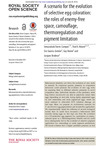A scenario for the evolution of selective egg coloration
| dc.contributor.author | Torres-Campos, Inmaculada | en_US |
| dc.contributor.author | Abram, Paul K. | en_US |
| dc.contributor.author | Guerra-Grenier, Eric | en_US |
| dc.date.accessioned | 2016-07-04T03:49:01Z | |
| dc.date.available | 2016-07-04T03:49:01Z | |
| dc.date.issued | 2016 | en_US |
| dc.identifier.other | HPU4160370 | en_US |
| dc.identifier.uri | https://lib.hpu.edu.vn/handle/123456789/21885 | en_US |
| dc.description.abstract | Behavioural plasticity can drive the evolution of new traits in animals. In oviparous species, plasticity in oviposition behaviour could promote the evolution of new egg traits by exposing them to different selective pressures in novel oviposition sites. Individual females of the predatory stink bugPodisus maculiventrisare able to selectively colour their eggs depending on leaf side, laying lightly pigmented eggs on leaf undersides and more pigmented eggs, which are more resistant to ultraviolet (UV) radiation damage, on leaf tops. | en_US |
| dc.format.extent | 13 p. | en_US |
| dc.format.mimetype | application/pdf | en_US |
| dc.language.iso | en | en_US |
| dc.subject | Biology | en_US |
| dc.subject | Ecology | en_US |
| dc.subject | Behaviour | en_US |
| dc.subject | Evolution | en_US |
| dc.subject | Egg pigmentation | en_US |
| dc.subject | Podisus maculiventris | en_US |
| dc.title | A scenario for the evolution of selective egg coloration | en_US |
| dc.type | Article | en_US |
| dc.size | 660KB | en_US |
| dc.department | Education | en_US |
Files in this item
This item appears in the following Collection(s)
-
Education [806]

